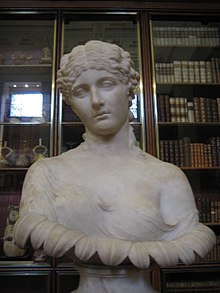| Clytie | |
|---|---|
| Member of the Oceanids | |
 Townley's Clytie | |
| Other names | Clytia |
| Greek | Κλυτίη |
| Abode | Boeotia, others |
| Symbols | Heliotropium |
| Genealogy | |
| Parents | Oceanus and Tethys or Orchomenus/Orchamus |
| Siblings | The Oceanids, the Potamoi or Leucothoe |
| Consort | Helios |
Clytie (/ˈklaɪtiiː/; Ancient Greek: Κλυτίη, romanized: Klutíē) or Clytia (/ˈklaɪtiə/; Ancient Greek: Κλυτία, romanized: Klutía) is a water nymph, daughter of the Titans Oceanus and Tethys in Greek mythology.[1][2][3] She is thus one of the 3,000 Oceanid nymphs, and sister to the 3,000 Potamoi (the river-gods).
According to the myth, Clytie loved the god of the sun Helios in vain,[4] but he left her for another woman, the princess Leucothoe, under the influence of Aphrodite, the goddess of love. In anger and bitterness, she revealed their affair to the girl's father, indirectly causing her doom as the king buried her alive. This failed to win Helios back to her, and she was left lovingly staring at him from the ground; eventually she turned into a heliotrope, a violet flower that gazes at the Sun in its diurnal journey.[5][6]
Clytie's story is mostly known from and fully preserved in Ovid's narrative poem Metamorphoses, though other brief accounts and references to her from other authors survive as well.
- ^ Her name appears in the long list of Oceanids in Hesiod, Theogony 346ff.
- ^ Hyginus, Fabulae Preface
- ^ Bane 2013, p. 87.
- ^ Two other minor personages name Clytie are noted: see Theoi Project: Clytie.
- ^ Waldner, Katharina (2006). "Clytia, Clytie". In Cancik, Hubert; Schneider, Helmuth (eds.). Brill's New Pauly. Translated by Christine F. Salazar. Berlin: Brill Reference Online. doi:10.1163/1574-9347_bnp_e617370. Retrieved September 18, 2023.
- ^ Wright, M. Rosemary. "A Dictionary of Classical Mythology: Summary of Transformations". mythandreligion.upatras.gr. University of Patras. Retrieved January 3, 2023.